#agileworld
Photo

#Innova8 combining #designthinking #servicedesign and #userexperience #customer validated services and products Innova8™ combines design thinking, service design and user experience within an 8 hour process, that takes #AgileWorldInc #AgileTransformation #AgileFinOps #LeanPortfolioManagement https://agile-world.us/innova8-combining-design-thinking-service-design-and-user-experience/?utm_source=tumblr&utm_medium=%23AgileWorld&utm_campaign=%23AgileWorld
#karlsmithuserexperienceu#hourinnvovation#agile#agilehumans#AgileWorld#AgileWorldUSA#Design#DesignThinking#DevOps#Digital#HumanCentered#INNOVATION#Lean#OrganisationalDesign
2 notes
·
View notes
Photo
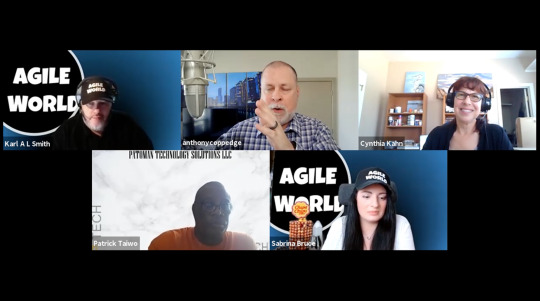
OKRs and KPIs in the wild with Anthony Coppedge S4 E9 OKRs and KPIs in the wild on Meetup with Anthony Coppedge Agile World Hot Topic with our hosts Sabrina C E Bruce and Karl A L Smith. OKRs and KPIs what they are, how they work and clear up some of the confusion around them in this live meetup session. Anthony leads the vision for driving program outcomes and coach leaders, managers, and teams how to deliver outcomes over outputs. He relishes the chance to sabotage mediocrity. He fuels his heart by mentoring leaders in business agility thinking, and by writing for, teaching, and coaching a variety of audiences. Teams he's worked with begin to get unstuck in weeks, not months, while the short-term successes motivate teams to continuously www.agile-world.news #AgileWorld #AgileTalkShow #Agile https://agile-world.news/okrs-and-kpis-in-the-wild-with-anthony-coppedge/?utm_source=tumblr&utm_medium=Agile+World&utm_campaign=Agile+World
#karlalsmith#agileworld#okrs#sabrinacebruce#agileworldhottopic#livediscussion#okr#meetup#anthonycoppedge#agiletalkshow#kpi#agileworldmeetup#hottopics#kpis
2 notes
·
View notes
Text
Creative Exercise
Sepuluh harian terakhir ini gue nyoba latihan kreativitas gitu, sederhana. Setiap hari gue kudu gambar gitu, awal nya dari 8 lingkaran.

Template nya kaya gini. Lingkaran nya bisa gue gedein atau kecilin yang jelas harus ada unsur lingkaran nya. Dan beginilah beberapa hasil gue wkwkkw
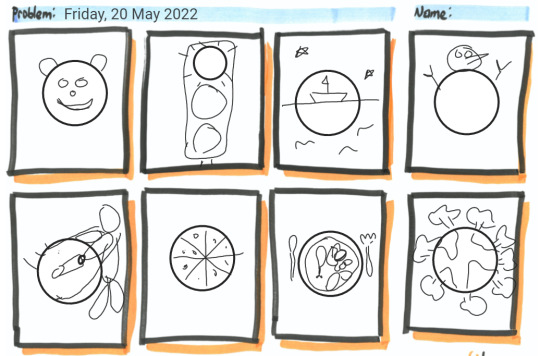

Gembel banget emang gambar nya, seadanya banget wkwkwk. Yaa karena asal nya gue gabisa gambar sih, itu juga kayanya yang ngerti maksud gambar nya gue doang deh. Walaupun jelek nya banget wkwkwkwkwk, dalam 2 minggu ini di gue kerasa dampak nya. Keliatan nya sepele banget, gambar-gambar asal. Tapi gue kerasa lebih kreatif gitu siah, lebih ngulik dari biasa nya dan lebih ga gampang nyerah gitu. Doain aja bisa konsisten gambar terus tiap pagi wkwkwkwk.
Jadi kotak-kotak itu namanya Crazy 8's. Ada di salah satu fase design sprint. Dulu gue pernah workshop sama pakar design sprint, beliau yang ngasih tau kalau kreativitas itu dilatih salah satu nya ya dengan warming up sebelum mulai aktivitas kerja dengan gambar lingkaran-lingkaran itu. Awal nya gue juga skeptis, masa iya sih. Skeptis nya sampe bertahun-tahun wkwk baru gue jalanin exercise nya akhir-akhir ini. Salah satu alasan terbesar nya ya karena gue ngerasa mandek, entah otak entah kreativitas sih.
Creative Exercise ini bisa dimodif sesuai keinginan sih. Misal mau gambar dasar nya kotak ya mangga, mau dari segitiga mangga. Tujuan nya sama-sama menarik crazy idea kita, yang sering nya emang ga muncul ke permukaan. Kreativitas itu dilatih, sama hal nya kaya kecerdasan sih ya. Tapi kayanya orang makin kreatif makin inisiatif sih wkwk.
Sekian, gue cuma mau berbagi kebahagiaan aja. Gambar-gambar itu 1 sketch dibuat paling ga sampe 10 menit, 5 menit juga kelar. Tapi bikin gue mikir dan memaksa gue untuk peka sama sekeliling "ada apalagi yang bisa gue gambar dari lingkaran ini?". Satu lagi, ga ada aturan waktu ngegambar, bebas, ga ada paksaan, ga ada yang bakal judge juga wkwk. Mungkin itu yang bikin gue seneng sih. Bersih dari prasangka orang hweheheheheheheh.
Ohiya gambar-gambar ini gue buat di jamboard, soal nya enak fitur nya minimalis jadi ga pening.
5 notes
·
View notes
Text
Kanban VS Scrum: Which is Best

Kanban and Scrum are the two main Agile methods for assisting teams in effectively collaborating on challenging projects. You've probably heard of one or the other, but what distinguishes them from one another? Instead of taking a predetermined linear path, the Kanban and Scrum frameworks use an iterative approach to product delivery that depends on speed, agility, and the capacity to modify as you go continuously.
There are several real-world distinctions between Scrum and Kanban, despite the general philosophical similarities between both. This article will examine such variations and assist you in selecting the most effective strategy.
What Is Kanban?
Agile software development is commonly implemented using the well-liked Kanban methodology, which emphasizes continuous delivery without putting undue strain on the development team. Team members may always view the status of the work by using a Kanban board to graphically depict work items. It is intended to facilitate better teamwork, much like Scrum.
Visualization:
Kanban strongly emphasizes using task-representing boards or cards to visualize work. Teams can handle tasks more efficiently when there is clarity on job status, bottlenecks, and progress thanks to this visual depiction.
Work in Progress (WIP) Limits:
Establishing work-in-progress (WIP) restrictions at every level of the workflow helps to keep things flowing smoothly and avoid overloading. It lessens multitasking, promotes attention, and points up areas that could require more resources.
Continuous Improvement:
By looking at KPIs, finding inefficiencies, and making small adjustments to streamline processes, Kanban encourages a culture of continuous improvement. To increase productivity and effectiveness, teams evaluate and modify their procedures regularly.
What Is Scrum?
Scrum is a straightforward framework that helps teams work together on challenging tasks. The word "scrum" comes from the rugby game, when players construct a formation where each person has a designated function and works to quickly adapt the strategy. Its goal is to provide outcomes as quickly as possible while placing a strong focus on cooperation and iterative improvement.
Transparency:
This focuses on being open and honest in communication, ensuring that all facets of the process are visible and clear to all parties.
Inspection:
To detect any deviations or problems early on and enable adaptation and development, routine inspection of the product and the processes is essential.
Adaptation:
Teams can modify and make the required changes to improve the process and the product going forward based on the inspection results.
Difference Between Scrum and Kanban:
Scrum and Kanban are both agile methodologies that emphasize iterative development and continuous improvement, but they have distinct structures and approaches to work and team management.
Kanban offers more flexibility, enabling continuous flow and adaption based on demand and capacity, whereas Scrum is more prescriptive, having a defined structure with roles and fixed-length iterations.
Methodology Focus: Kanban promotes constant flow and task visualization on a board, giving process management flexibility. Scrum emphasizes iterative development using predetermined sprint lengths and rituals like sprint planning and review.
Planning Approach: Work is pulled when capacity permits in a continuous, flexible planning process known as kanban. Scrum plans operate in set iterations, or sprints, with a specific goal for every one of them.
Roles and Responsibilities: Kanban encourages flexibility in team organization by not dictating responsibilities. In Scrum, there are defined roles like Scrum Master, Product Owner, and the Development Team, each with specific responsibilities.
Work Structure: Kanban facilitates continuous delivery and adaption by permitting modifications at any point during the process. Scrum ensures stability inside the sprint by locking the scope for the whole period.
Time Management: Lead time and cycle time tracking are the main goals of Kanban to maximize workflow efficiency. Scrum places a strong emphasis on sprint length and tracks progress within each sprint using burn-down charts.
Continuous Improvement: Through frequent process analysis and optimization, Kanban encourages teams to work towards continuous improvement. Retrospective meetings, held following each sprint to discuss what went well and what may be improved for the following sprint, are one way that Scrum promotes improvement.
Kanban Or Scrum, Which One Is Better?
The particular requirements and circumstances of a project or team will determine which of the two approaches is best. Each provides advantages that are better suited for certain circumstances, but none is really "better" overall.
Kanban might be more suitable when:
The workflow entails regular modifications along with continual delivery.
It's important to be adaptable while handling varying workloads or priorities.
Reducing bottlenecks and maximizing flow efficiency are important to the team.
Scrum might be more suitable when:
The project gains from an organized, time-limited methodology with set iterations.
Project management and stakeholder expectations depend heavily on regular deliverables and well-defined milestones.
A well-defined procedure with designated roles and ceremonies is required. Effective frameworks are provided by both Scrum and Kanban, and the decision between them is influenced by several elements like project needs, team dynamics, and the type of work being done. Certain teams even merge components of both frameworks (called Scrumban) to produce a hybrid strategy that works for their particular requirements.
What We Get?
It's critical to evaluate the unique requirements of your project while choosing between Scrum and Kanban. Kanban provides continuous flow and flexibility, making it perfect for dynamic situations and procedures that adapt. Scrum, on the other hand, offers structure and set iterations, making it appropriate for projects with well-defined deliverables and milestones.
Considering these frameworks? Vizz Web Solutions is an expert in Scrum and Kanban, customizing methods to meet your requirements. They maximize project success through controlled development or flexible flow.
#kanban#scrum#software#agile#business#books & libraries#agiledevelopment#agileworld#agile project management
1 note
·
View note
Text
The Secret to Speeding Up Software Delivery: How DevOps Can Help
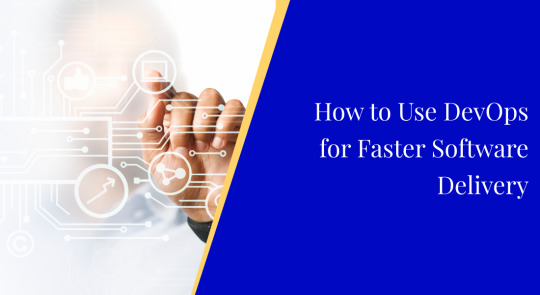
Introduction
DevOps is a set of practices and tools that aim to improve collaboration and communication between development and operations teams in order to deliver software faster and more efficiently. By implementing DevOps, organizations can improve their software development and delivery process, reduce human error and increase efficiency. In this blog post, we will explore how organizations can use DevOps to speed up their software delivery process and improve quality. With the right tools and practices, you can streamline your workflow, automate repetitive tasks, and foster a culture of collaboration. Whether you're new to DevOps or looking to optimize your existing workflow, this post will provide valuable insights and practical tips to help you improve your software delivery process.
Defining your workflow: Understanding your current process
Defining your workflow is an essential step in using DevOps for faster software delivery. Before you begin implementing DevOps, it's important to have a clear understanding of your current software development and delivery process. This will help you identify areas that can be improved and streamline your workflow for faster delivery.
To define your workflow, you should first document the current process from start to finish. This includes everything from writing code and testing to deploying and monitoring your application. It's important to involve all stakeholders, including developers, testers, and operations teams, in this process to ensure that everyone has a clear understanding of the current workflow.
Once you have a clear understanding of the current process, you can start identifying areas that can be improved. Common bottlenecks that slow down software delivery include manual tasks, lack of communication, and inconsistent processes. By identifying these bottlenecks, you can develop a plan to address them and improve your workflow.
In addition to identifying bottlenecks, it's also important to establish clear roles and responsibilities for each team member. This will help ensure that everyone is on the same page and working towards the same goal of faster software delivery.
Overall, defining your workflow is a crucial step in using DevOps for faster software delivery. By understanding your current process, identifying areas for improvement and establishing clear roles and responsibilities, you can create a workflow that is optimized for speed and efficiency.
For ecommerce software development services Click here.
Automating your processes: Reducing human error and increasing efficiency
Automating your processes is a key principle of DevOps that helps organizations reduce human error and increase efficiency. Automation can help streamline repetitive tasks, such as building, testing and deploying code, freeing up valuable time for developers to focus on more important tasks.
There are a variety of tools available for automating different aspects of the software development and delivery process. For example, Jenkins is a popular open-source tool for automating builds, testing and deployment. It allows you to set up a continuous integration (CI) pipeline, where code changes are automatically built, tested, and deployed as soon as they are committed to the source code repository. This helps catch and fix issues early on in the development process.
Another popular tool for automation is Ansible. This is an open-source automation tool that can be used to automate repetitive tasks such as configuring servers, deploying software and provisioning infrastructure. Ansible allows you to write simple scripts called playbooks, which can be executed to perform a set of tasks on multiple servers at once.
By automating repetitive tasks, you can reduce human error and improve efficiency, making it easier to deliver software faster. By using tools like Jenkins and Ansible, organizations can automate their process and create a more efficient and streamlined software delivery process.
It's worth noting that while automation is a powerful tool, it should be used judiciously and not all tasks may be suitable for automation. It is important to evaluate which tasks are most critical to automate and which can be done manually with the same or better results.
Implementing continuous integration: Catching and fixing issues early
Implementing continuous integration (CI) is a key component of DevOps that helps organizations catch and fix issues early on in the development process. With CI, code changes are automatically built, tested, and deployed as soon as they are committed to the source code repository. This helps to identify and fix issues early on, before they become bigger problems that are harder and more time-consuming to fix.
There are several popular tools available for implementing CI, such as Jenkins, Travis CI, and CircleCI. These tools can be configured to automatically build, test, and deploy code changes as soon as they are committed to the repository. They can also be configured to send notifications to the development team when build or test failures occur, so that issues can be addressed in a timely manner.
CI is not just about automating the build and test process, but it also includes the integration of different features and functionalities and also testing them together as a whole. This helps to ensure that code changes do not break existing functionality, and that the application is in a releasable state at all times.
In addition, CI can also include the use of automated testing, which can help catch issues early on and reduce the need for manual testing. This can save a lot of time and effort, and improve the overall quality of the software.
Overall, implementing CI is an essential part of using DevOps for faster software delivery. By catching and fixing issues early on, organizations can reduce the time and effort required to deliver software and improve the overall quality of the application.
Using containerization: Ensuring consistency across environments
Using containerization, such as Docker, is another key component of DevOps that helps organizations ensure consistency across development, staging, and production environments. Containerization allows you to package your application and its dependencies into a single container, which can then be easily deployed and run on any machine that supports the container runtime.
One of the main benefits of containerization is that it helps to ensure that your application runs the same way in development, staging, and production environments. This eliminates the "works on my machine" problem, where an application runs fine on a developer's machine but fails when deployed to production. By containerizing your application, you can ensure that it runs the same way everywhere, reducing the risk of environment-specific issues.
Another benefit of containerization is that it allows you to deploy your application more efficiently. Containers are lightweight and can be easily deployed and scaled across multiple machines, making it easy to handle the load of high-traffic applications.
In addition, containerization also helps with the management of dependencies and libraries, by packaging them together with the application, this can help to avoid version conflicts and ensure that the application is running with the correct dependencies.
Overall, containerization is a powerful tool for ensuring consistency across environments and improving the efficiency of your software delivery process. By using containerization, organizations can reduce the risk of environment-specific issues and deploy their applications more efficiently.
Monitoring and measuring: Optimizing your DevOps workflow with key performance indicators.
Monitoring and measuring are essential components of DevOps that help organizations optimize their workflow and improve the speed and efficiency of their software delivery process. By collecting and analyzing data, organizations can identify areas for improvement and make informed decisions about how to optimize their workflow.
There are a variety of tools available for monitoring and measuring different aspects of the software development and delivery process. For example, Prometheus and Datadog are popular open-source monitoring tools that can be used to collect and analyze data on key performance indicators (KPIs) such as deployment frequency, lead time, and failure rate. These tools can also be used to monitor the performance of your application in production, which can help you identify and fix issues before they impact users.
It's important to monitor and measure the right KPIs for your organization. Some examples of KPIs that organizations might track include:
Deployment frequency: how often new versions of the application are released to production.
Lead time: the time it takes for a change to be committed to the source code repository to the time it's deployed to production.
Failure rate: the percentage of deployments that result in an error or failure.
Time to recover: the time it takes to fix a production issue and bring the service back to normal operation.
By monitoring and measuring these KPIs, organizations can get a clear picture of the efficiency and effectiveness of their software delivery process and identify areas that need improvement. With this data, they can make informed decisions about how to optimize their workflow, reduce lead time and improve the overall quality of their software delivery.
Monitoring and measuring are essential components of using DevOps for faster software delivery. By collecting and analyzing data on key performance indicators, organizations can optimize their workflow and improve the speed and efficiency of their software delivery process.
In conclusion, DevOps is a powerful set of practices and tools that can help organizations improve their software development and delivery process. By streamlining your workflow, automating repetitive tasks, implementing continuous integration, using containerization, and monitoring and measuring key performance indicators, organizations can reduce human error, increase efficiency, and deliver software faster.
However, it's important to remember that DevOps is not just about tools and processes, but also about culture. Encourage collaboration and communication between development and operations teams to ensure that everyone is working towards the same goal of faster software delivery.
If you're new to DevOps or looking to optimize your existing workflow, the tips and insights provided in this blog post can help you get started. As always, keep learning and stay up-to-date with the latest developments and best practices in the DevOps field.
We encourage you to start implementing these strategies in your own organization and track your progress. You will be surprised how much time and effort you can save by using DevOps practices. Remember that it's not an overnight change, and it takes time to adapt and optimize it to your organization's process. But the benefits are worth it in the end.
Hope you find the information which you have been looking for. For more information or queries regarding any software development services, you can contact us.
#business#coding#programming#softwaredevelopment#webdevelopment#software#softwaredeveloper#tech#technology#devops#tools#it#information technology#agile#agileworld
1 note
·
View note
Photo

When Agile becomes Fragile nobody Wins I have been an Agile practitioner a very long time, in fact as an Instructional Designer I was very excited when Agile was created based upon Computer Human Interaction methods and thinking. As one complete fully applied process Agile #AgileWorldInc #AgileTransformation #AgileFinOps #LeanPortfolioManagement https://agile-world.us/when-agile-becomes-fragile-nobody-wins/?utm_source=tumblr&utm_medium=%23AgileWorldInc&utm_campaign=%23AgileWorldInc
#karlsmithuserexperienceu#agile#agilehumans#AgileWorld#AgileWorldUSA#CHANGEMANAGEMENT#DevOps3#Fragile#PlanningPoker#PracticalAgile
2 notes
·
View notes
Photo

#Blockchain end to financial services and banking #STP and #BPO Accounting? In the same way that digital downloads has crippled the mass market of vinyl and CD's does Blockchain means the end of financial services and banking straight through processing and the #AgileWorldInc #AgileTransformation #AgileFinOps #LeanPortfolioManagement https://agile-world.us/is-blockchain-bringing-the-end-to-financial-services-and-banking-stp-and-accountancy/?utm_source=tumblr&utm_medium=%23AgileWorldInc&utm_campaign=%23AgileWorldInc
#karlsmithuserexperienceu#accountancy#agileworld#agileworldusa#avaloq#banking#blockchain#bpo#financialservices#oracle#stp#temenos
3 notes
·
View notes
Photo

Nasreen Elizabeth Hypn Breathing Nazreen Elizabeth shares her journey towards Hypno Breathing, how it can help you and how she left a omfy government career to follow her passion. Now's your chance to experience this and it's amazing. Website https://francescasipma.com/ To book a session with Naz: [email protected] Nasreenelizabeth.com My IG: @nasreen.elizabeth On YouTube On Vimeo #Agile_World #AgileWorld #AgileWellness #Mindset Wellness Agile World Wellness LinkedIn Agile World Wellness Facebook Agile World Wellness YouTube Agile World Broadcast Media Agile World Website Agile World Facebook Agile World LinkedIn Agile World Instagram Agile World Twitter Agile World Pinterest Agile World Tumblr Agile World Medium Video Agile World www.agile-world.news #AgileWorld #AgileTalkShow #Agile https://agile-world.news/nasreen-elizabeth-hypn-breathing/?utm_source=tumblr&utm_medium=Agile+World&utm_campaign=Agile+World
#nasreenelizabeth#agileworld#stevemoubray#sabrinacebruce#breathing#hypnbreathing#hypnosis#hypnobreathing
2 notes
·
View notes
Photo

Agile World acknowledges project Charlemagne a unified IoT, Information Architecture and Blockchain platform Agile World has decided to get involved in building products to service the IoT marketplace represented by Smart Living and #AgileWorldInc #AgileTransformation #AgileFinOps #LeanPortfolioManagement https://agile-world.us/agile-world-acknowledges-project-charlemagne-a-unified-iot-ia-and-blockchain-platform/?utm_source=tumblr&utm_medium=%23AgileWorldInc&utm_campaign=%23AgileWorldInc
#karlsmithuserexperienceu#agilehumans#agileworld#agileworldusa#blockchain#ethereum#ia#iot#iotconsultancy#iotfmcg#iotitems#iotproducts#karlsmith#projectcharlemagne
2 notes
·
View notes
Photo

Agile World Consulting grants Agile World Incorporated CA Agile World Consulting grants Agile World Incorporated CA right to use it trademark for nonprofit activities. As part of Agile World ® continued support of Agile World Incorporated, CA we confirm the right to use our trademark property Agile World ® for nonprofit activities. These activities include; Agile World Incorporated #AgileWorldInc #AgileTransformation #AgileFinOps #LeanPortfolioManagement https://agile-world.us/agile-world-grants-agile-world-incorporated-ca/?utm_source=tumblr&utm_medium=%23AgileWorld&utm_campaign=%23AgileWorld
0 notes
Photo

#Minimum #Viable #Experience #MVE because the viability in an #MVP is not #Customer #Centered MVP is all people talk about in development these days, like it's the fix for every problem, unfortunately it creates a whole new set of #AgileWorldInc #AgileTransformation #AgileFinOps #LeanPortfolioManagement https://agile-world.us/minimum-viable-experience-mve-because-the-viability-in-an-mvp-is-not-customer-centered/?utm_source=tumblr&utm_medium=%23AgileWorld&utm_campaign=%23AgileWorld
#karlsmithuserexperienceu#AgileWorld#AgileWorldUSA#brand#branddamage#brandequity#CustomerCentered#customercentric#MinimumViableExperience#MinimumViableProduct#MVE#MVP
0 notes
Photo
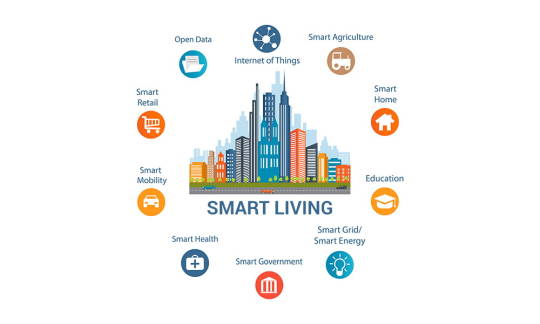
#SmartLiving or as we might live with #artificial #intelligence and an open #IoT in a #new #reality Karl Smith, CEO of Agile World tends to think of himself as a futurist, he immediately see the possibilities of #AgileWorldInc #AgileTransformation #AgileFinOps #LeanPortfolioManagement https://agile-world.us/smart-living-or-as-we-might-live-with-artificial-intelligence-and-the-iot-in-a-new-reality/?utm_source=tumblr&utm_medium=%23AgileWorld&utm_campaign=%23AgileWorld
#karlsmithuserexperienceu#agilehumans#AgileWorld#AgileWorldUSA#AI#Digital#DigitalLiving#IoT#SCADA#Smart#SmartAgriculture#SmartEnergy#SmartGrid#SmartHealth#SmartHome#SmartWork
0 notes
Photo

#Global #Digital #Consultancy #Market #Differentiators I offer several strategic consultancy services one of them is Organizational Design this can involve launching a new service or creating new divisions or even whole Global #AgileWorldInc #AgileTransformation #AgileFinOps #LeanPortfolioManagement https://agile-world.us/global-digital-consultancy-start-up-pt1-market-differentiators/?utm_source=tumblr&utm_medium=%23AgileWorld&utm_campaign=%23AgileWorld
#karlsmithuserexperienceu#AgencyLaunch#agilehumans#AgileWorld#AgileWorldUSA#BusinessLaunch#DevOps3#DigitalService#OrganizationalDesign#PropositionDevelopment#servicedesign
0 notes
Photo

#Open #IoT with #Blockchain #AI and #BigData Ubiquity (IoT3) does not exist yet There will be many people who will say it does exist and has working technologies, hardware and software. The Ubiquity (IoT3) is not a closed system related to one task or feature set like Home Management It is an #AgileWorldInc #AgileTransformation #AgileFinOps #LeanPortfolioManagement https://agile-world.us/ubiquity-iot-does-not-exist-yet-how-will-it-work-with-blockchain-ai-and-bigdata-for-humans/?utm_source=tumblr&utm_medium=%23AgileWorld&utm_campaign=%23AgileWorld
0 notes
Photo

State of Agile Culture 2023 with Agile World Consulting Agile World Consulting is supporting the 2023 Agile Culture research project. This project is being delivered using unique technology within a survey that collects the truth about #AgileWorldInc #AgileTransformation #AgileFinOps #LeanPortfolioManagement https://agile-world.us/state-of-agile-culture-2023-with-agile-world-consulting/?utm_source=tumblr&utm_medium=%23AgileWorld&utm_campaign=%23AgileWorld
#agile#AgileBusinessConsortium#agileculture#AgileWorld#AgileWorldInstitute#AgileWorldNews#AgileWorldPublishing#agility#change#culture#JCURV#Leadership#Neurotech#Truthsayers
0 notes
Photo
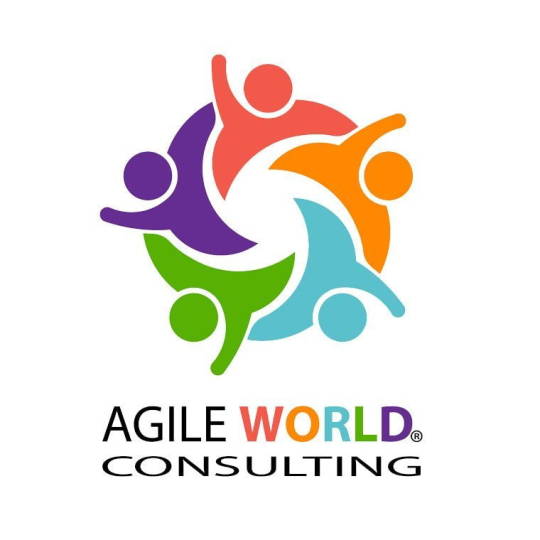
NOTICE OF TRADEMARK INFRINGEMENT of Agile World ® in the USA and in the European Union NOTICE OF TRADEMARK INFRINGEMENT of Agile World ® in the USA and in the European Union. First Use: Mar. 31, 2006 Use in Commerce: Mar. #AgileWorldInc #AgileTransformation #AgileFinOps #LeanPortfolioManagement https://agile-world.us/notice-of-trademark-infringement-of-agile-world-in-the-usa-and-in-the-european-union/?utm_source=tumblr&utm_medium=%23AgileWorld&utm_campaign=%23AgileWorld
#AgileWorld#Austria#Belgium#Bulgaria#Croatia#CzechRepublic#Denmark#Estonia#Finland#France#Germany#Greece#Hungary#Ireland#Italy#Latvia#Lithuania#Luxembourg#Malta#Netherlands#Poland
0 notes